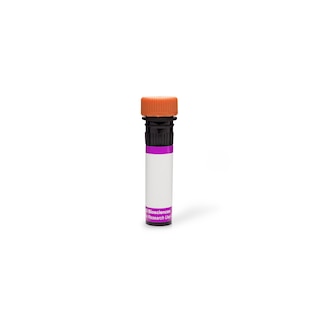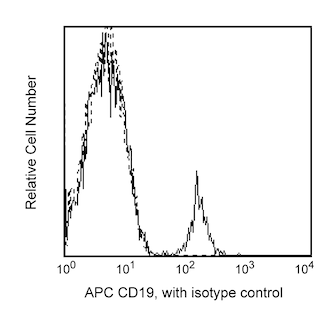-
Your selected country is
Middle East / Africa
- Change country/language
Old Browser
This page has been recently translated and is available in French now.
Looks like you're visiting us from {countryName}.
Would you like to stay on the current country site or be switched to your country?




Two-color flow cytometric analysis of IgM expression on human peripheral blood lymphocytes. Human peripheral blood mononuclear cells were incubated in complete medium overnight in order to minimize subsequent nonspecific immunofluorescent staining. The cells were harvested and stained with APC Mouse Anti-Human CD19 antibody (Cat. No. 555415/561742) and either BD Horizon™ BV605 Mouse IgG1, k Isotype Control (Cat. No. 562652; Left Panel) or BD Horizon™ BV605 Mouse Anti-Human IgM antibody (Cat. No. 562977; Right Panel). Two-color flow cytometric dot plots showing the correlated expression of cell surface IgM (or Ig Isotype control staining) versus CD19 were derived from gated events with the forward and side light-scatter characteristics of viable lymphocytes. Flow cytometric analysis was performed using a BD™ LSR II Flow Cytometer System.


BD Horizon™ BV605 Mouse Anti-Human IgM

Regulatory Status Legend
Any use of products other than the permitted use without the express written authorization of Becton, Dickinson and Company is strictly prohibited.
Preparation And Storage
Product Notices
- This reagent has been pre-diluted for use at the recommended Volume per Test. We typically use 1 × 10^6 cells in a 100-µl experimental sample (a test).
- Source of all serum proteins is from USDA inspected abattoirs located in the United States.
- An isotype control should be used at the same concentration as the antibody of interest.
- Please refer to www.bdbiosciences.com/us/s/resources for technical protocols.
- Please observe the following precautions: Absorption of visible light can significantly alter the energy transfer occurring in any tandem fluorochrome conjugate; therefore, we recommend that special precautions be taken (such as wrapping vials, tubes, or racks in aluminum foil) to prevent exposure of conjugated reagents, including cells stained with those reagents, to room illumination.
- Caution: Sodium azide yields highly toxic hydrazoic acid under acidic conditions. Dilute azide compounds in running water before discarding to avoid accumulation of potentially explosive deposits in plumbing.
- For fluorochrome spectra and suitable instrument settings, please refer to our Multicolor Flow Cytometry web page at www.bdbiosciences.com/colors.
- Although every effort is made to minimize the lot-to-lot variation in the efficiency of the fluorochrome energy transfer, differences in the residual emission from BD Horizon™ BV421 may be observed. Therefore, we recommend that individual compensation controls be performed for every BD Horizon™ BV605 conjugate.
- CF™ is a trademark of Biotium, Inc.
Companion Products





IgM is an important component in the first line of defense against foreign pathogens, but may also play a role in autoimmune diseases. IgM monomers consist of two light and two heavy chains. Unlike the heavy chain of an IgG antibody which contains 3 constant Ig domains, the µ heavy chain of IgM contains 4 constant Ig domains. Five IgM monomers complex with a small polypeptide (J-chain) to form pentameric IgM that can be found in human plasma. In an immune response, the binding of IgM to a cell surface antigen enables C1q to activate interactions with downstream components in the classical complement pathway. Mature B lymphocytes express IgM. The G20-127 monoclonal antibody binds to the heavy chain of human IgM. The G20-127 antibody is not thought to react with other immunoglobulin heavy chain isotypes.
This antibody is conjugated to BD Horizon BV605 which is part of the BD Horizon Brilliant™ Violet family of dyes. With an Ex Max of 407-nm and Em Max of 602-nm, BD Horizon BV605 can be excited by a violet laser and detected with a standard 610/20-nm filter set. BD Horizon BV605 is a tandem fluorochrome of BD Horizon BV421 and an acceptor dye with an Em max at 605-nm. Due to the excitation of the acceptor dye by the green (532 nm) and yellow-green (561 nm) lasers, there will be significant spillover into the PE and BD Horizon PE-CF594 detectors off the green or yellow-green lasers. BD Horizon BV605 conjugates are very bright, often exhibiting brightness equivalent to PE conjugates and can be used as a third color off of the violet laser.
For optimal and reproducible results, BD Horizon Brilliant Stain Buffer should be used anytime two or more BD Horizon Brilliant dyes are used in the same experiment. Fluorescent dye interactions may cause staining artifacts which may affect data interpretation. The BD Horizon Brilliant Stain Buffer was designed to minimize these interactions. More information can be found in the Technical Data Sheet of the BD Horizon Brilliant Stain Buffer (Cat. No. 563794).

Development References (5)
-
Chtanova T, Tangye SG, Newton R, et al. T follicular helper cells express a distinctive transcriptional profile, reflecting their role as non-Th1/Th2 effector cells that provide help for B cells. J Immunol. 2004; 173(1):68-78. (Clone-specific: Flow cytometry). View Reference
-
Le Gallou S, Caron G, Delaloy C, Rossille D, Tarte K, Fest T. IL-2 requirement for human plasma cell generation: coupling differentiation and proliferation by enhancing MAPK-ERK signaling. J Immunol. 2012; 189(1):161-173. (Clone-specific: Flow cytometry). View Reference
-
Mei HE, Yoshida T, Sime W, et al. Blood-borne human plasma cells in steady state are derived from mucosal immune responses. Blood. 2009; 113(11):2461-2469. (Clone-specific: Flow cytometry, Immunofluorescence). View Reference
-
Widhopf GF, 2nd, Brinson DC, Kipps TJ, Tighe H. Transgenic expression of a human polyreactive Ig expressed in chronic lymphocytic leukemia generates memory-type B cells that respond to nonspecific immune activation. J Immunol. 2004; 172(4):2092-2099. (Clone-specific: Flow cytometry). View Reference
-
Zola H, Macardle PJ, Flego L, Webster J. The expression of sub-population markers on B cells: a re-evaluation using high-sensitivity fluorescence flow cytometry. Dis Markers. 1991; 9(2):103-118. (Biology: Cell differentiation, Dot Blot, Flow cytometry, Fluorescence activated cell sorting, In situ hybridization). View Reference
Please refer to Support Documents for Quality Certificates
Global - Refer to manufacturer's instructions for use and related User Manuals and Technical data sheets before using this products as described
Comparisons, where applicable, are made against older BD Technology, manual methods or are general performance claims. Comparisons are not made against non-BD technologies, unless otherwise noted.
For Research Use Only. Not for use in diagnostic or therapeutic procedures.
Report a Site Issue
This form is intended to help us improve our website experience. For other support, please visit our Contact Us page.